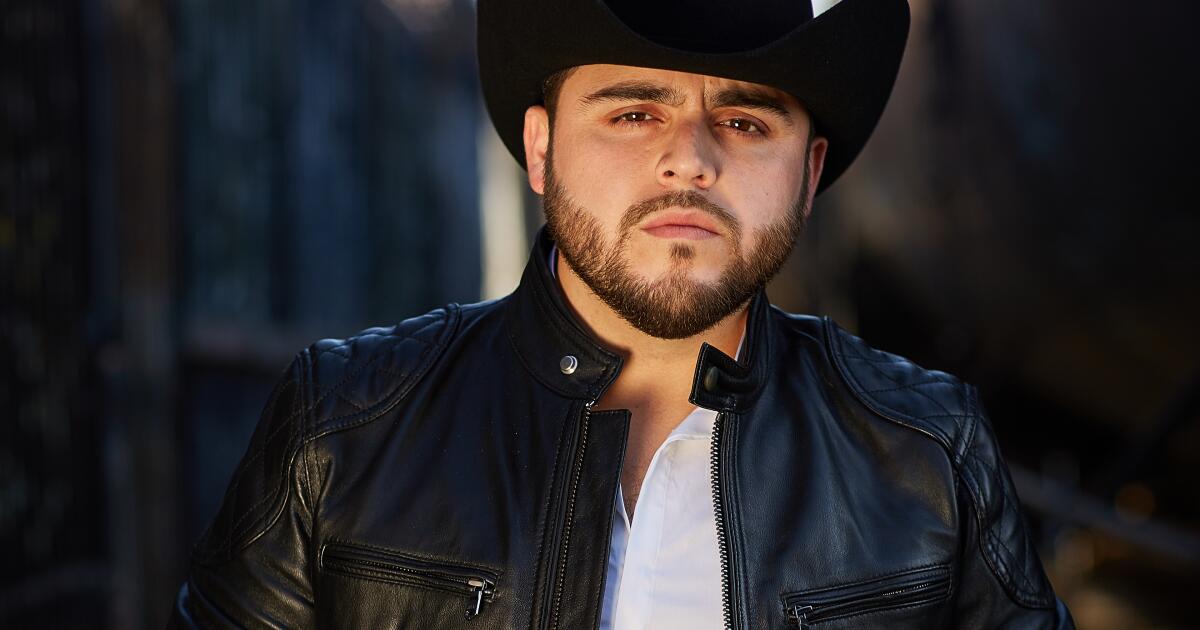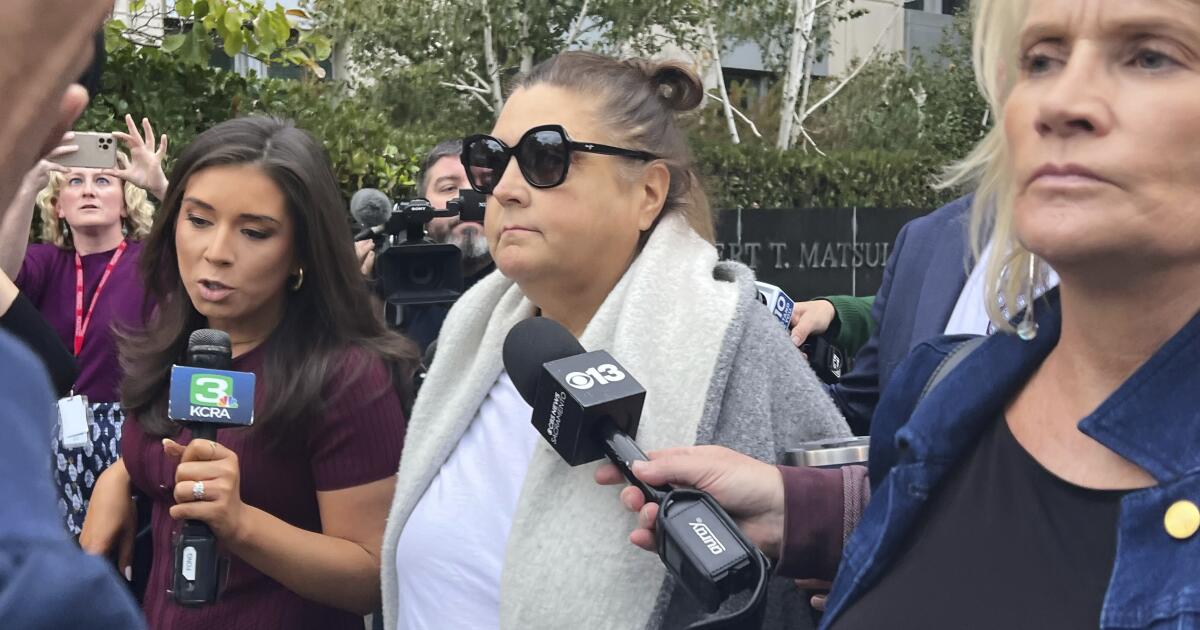As Gov. Gavin Newsom flew around the country last year campaigning for President Biden and Vice President Kamala Harris, his chief of staff Dana Williamson — known as one of California’s toughest political insiders — was not only helping to helm the ship in Sacramento, but under criminal investigation by federal law enforcement.
The resulting criminal case, which splashed into public view with Williamson’s arrest Wednesday, does not implicate Newsom in any wrongdoing. Williamson’s alleged misdeeds occurred in private work prior to her joining his staff, and his office said it placed her on leave in November 2024 after she informed him she was under investigation.
Nonetheless, the bombshell allegations struck at the center of the political power circle surrounding Newsom, rattling one of the nation’s most prominent and important hubs of Democratic state power at a time when President Trump and his Republican administration wield power in Washington.
Williamson was charged with bank and tax fraud for allegedly siphoning campaign and COVID-19 recovery funds into her and an associate’s pockets and claiming personal luxuries as business expenses on tax forms. According to the indictment, the campaign funds were drawn from a dormant state account of another top California Democrat: gubernatorial candidate and former U.S. Health and Human Services secretary Xavier Becerra.
Two other well-connected aides in state politics were also charged — and struck plea deals confirming the scheme — while a third, with deep ties to one of the most well-connected circles of political and business consultants in the country, appeared in charging documents as an uncharged co-conspirator.
Williamson’s attorney McGregor Scott, a former U.S. attorney in Sacramento, told The Times on Wednesday that federal authorities had approached Williamson more than a year ago, seeking help with some kind of probe of the governor himself.
“She told them she had no information to provide them, and then we wind up today with these charges,” Scott said. The nature of that alleged probe is unclear.
Newsom’s office on Thursday said it was “not aware of any federal investigation involving the governor.”
Lauren Horwood, a spokesperson for the U.S. attorney’s office in Sacramento, said she could not confirm or deny the existence of any investigation involving Newsom, in accordance with Justice Department policy. None of the charging documents released in the cases against the three aides mention Newsom.
A loquacious liberal foil to Trump and likely 2028 presidential contender, Newsom has been in Brazil since Sunday and on Wednesday left for a planned trip into the Amazon with a small delegation after attending the United Nations climate summit known as COP30. He left the conference before news of Williamson’s arrest, and could not be reached directly by The Times for comment.
In his absence, Newsom’s representatives have tried to draw a connection between the federal case and the contentious relationship between California and the Trump administration, though offered no evidence that the investigation was influenced by the White House.
“At a time when the president is openly calling for his attorney general to investigate his political enemies, it is especially important to honor the American principle of being innocent until proven guilty in a court of law by a jury of one’s peers,” a Newsom spokesperson said Wednesday.
“Under the Trump administration, the DOJ routinely targets the state, which has resulted in us suing the federal administration 46 times,” a Newsom spokesperson said Thursday.
Trump and his administration have been accused of using their power — and control over the Justice Department — to go after his political enemies. Charges reportedly deemed weak and unfounded by career prosecutors have been brought forward anyway against former FBI Director James Comey and New York Atty. Gen. Letitia James, while Sen. Adam Schiff (D-Calif.) is being investigated for years-old occupancy claims in mortgage documents. All have denied wrongdoing.
The case against Williamson and the other California aides, however, is something different — originating years ago under the Biden administration.
“Today’s charges are the result of three years of relentless investigative work, in partnership with IRS Criminal Investigation and the U.S. Attorney’s Office,” FBI Sacramento Special Agent in Charge Sid Patel said Wednesday.
Abigail Jackson, a White House spokesperson, rejected the notion that the case was in any way driven by the Trump administration or politically motivated.
“What an absurd claim to make when public reporting has already noted that this investigation began under the Biden DOJ,” Jackson said. “The Trump administration is restoring integrity and accountability to the Justice Department.”
Prosecutors also have plea deals with two of the primary suspects in the case, in which they corroborate some of the allegations.
According to the 23-count indictment, unsealed Wednesday morning, Williamson conspired with Sean McCluskie — a former top aid to Becerra — and lobbyist Greg Campbell to bill Becerra’s dormant state campaign account for bogus consulting services. The three allegedly used shell companies to funnel money out of the campaign fund starting in 2022.
Federal authorities alleged the bulk of the payments were made to McCluskie’s wife, who did not actually provide consulting services, and deposited into an account accessed by McCluskie. Becerra, who has not been accused of wrongdoing, said Wednesday’s charges alleging “impropriety by a long-serving trusted advisor are a gut punch,” and that he was cooperating with authorities.
In addition, Williamson was charged with falsifying documents for a COVID-era small business loan, and with claiming luxury goods and services — including a $15,353 Chanel purse, $21,000 in private jet travel and a $150,000 birthday trip to Mexico, complete with an $11,000 yacht trip — as business expenses on her tax returns, federal prosecutors said.
Williamson appeared in federal court in Sacramento on Wednesday afternoon, and pleaded not guilty to the charges.
Williamson’s attorney said he has been in “regular communication” with federal prosecutors about the case for some time, and had asked to meet with prosecutors to “present our side” before any charges were brought, but that request “was not honored.”
Instead, officials “chose grandstanding instead of the normal process” and arrested Williamson at home Wednesday, despite her being seriously ill and in need of a liver transplant, Scott said. Williamson could not be reached for comment directly.
Williamson previously worked as a Cabinet secretary to former Gov. Jerry Brown, who also could not be reached for comment Thursday.
The case against Williamson is bolstered by acknowledgments of guilt from at least two others.
McCluskie — a former chief deputy attorney general of California when Becerra was attorney general — pleaded guilty to conspiracy to commit fraud and is cooperating with authorities, court filings show. He could not be reached for comment.
Campbell pleaded guilty to conspiracy to commit fraud and conspiracy to defraud and commit offenses against the U.S. government. Campbell’s attorney Todd Pickles said his client “takes full accountability for his actions and is cooperating fully with the legal process.”
The case also involves another longtime California political insider: Alexis Podesta, a former secretary of the California Business, Consumer Services and Housing Agency who Newsom appointed to the State Compensation Insurance Fund board of directors in January 2020. A spokesperson for the board confirmed Podesta remained a member as of Thursday morning.
Bill Portanova, Podesta’s attorney, confirmed to The Times that Podesta is the person identified as “Co-Conspirator 2” in charging documents — including McCluskie’s plea agreement, which alleges she funneled the campaign funds to him.
Portanova said Podesta inherited responsibilities for handling the Becerra account from Williamson when Williamson left to become Newsom’s chief of staff. Podesta did not perceive anything “unusual about the accounts, how they were set up or who had set them up,” so continued making payments as previously arranged, Portanova said.
However, “when confronted with the information that it was improper payments,” Portanova said, she immediately stopped the payments, and “has been fully cooperative with the federal authorities at every stage of these proceedings.”
He said she is not charged, and “should not be charged” moving forward. He otherwise declined to comment, as “investigations are ongoing.”
Podesta had close ties to some of the most influential Democratic political consultants in California, adding to the intrigue surrounding the case.
In September 2020 — about eight months after Newsom had appointed Podesta to the insurance board for workers’ compensation — Politico reported on a new “influence superteam” of Democratic political consultants forming in California.
The project, it said, would be called the Collaborative. Among its “architects” were Williamson and Campbell, as well as Jim DeBoo, another former Newsom chief of staff. Its managing director, the outlet reported, would be Podesta.
Among its enlisted consultants, it said, would be Sean Clegg of Bearstar Strategies, another senior advisor to Newsom, and Shannon Murphy, of M Strategic Communications, who has ties to Los Angeles Mayor Karen Bass.
DeBoo, Clegg and Murphy have not been accused of any wrongdoing.
“Bearstar participated in a joint marketing press release with the Collaborative and worked on one campaign with the Collaborative’s members in 2022. Bearstar and its partners had no interest, stake or other involvement with this entity,” David Beltran, a representative of Bearstar, said in a statement Thursday.
Murphy also released a statement about the enterprise: “Five years ago, our firm participated in a joint-marketing effort. We had zero ownership or role in the business entity that was created and had no knowledge of its finances or operations until yesterday’s news stories.”
DeBoo did not respond to requests for comment Thursday.
Members of the Collaborative advise some of the largest companies in not just the country, but the world.
The Collaborative’s website was recently scaled down to a simple landing page, but it previously touted itself there as “the hub for the most talented public affairs, campaign, crisis management, communications and lobbying firms in California,” providing clients “the ability to choose one or several firms that work together — rather than compete — to provide their clients with the best possible outcomes.”
The website led with what it called a proverb: “If you call one wolf, you invite the pack.”

